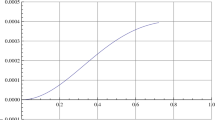The karyon-module (\( \mathcal{K}\mathrm{\mathcal{M}}\hbox{-} \)) algorithm for expanding an algebraic number α = (α1, . . . , αd) from ℝd in a multidimensional continued fraction, i.e., in a sequence of rational numbers
from ℚd with numerators \( {P}_1^a,\dots, {P}_d^a\in \mathrm{\mathbb{Z}} \) and a common denominator Qa = 1, 2, 3, . . . is proposed. The \( \mathcal{K}\mathrm{\mathcal{M}} \)-algorithm belongs to the class of tuned algorithms and is based on constructing localized Pisot units ζ > 1, for which the moduli of all the conjugates ζ(i) ≠ ζ are contained in the θ- neighborhood of the number ζ−1/d, where the parameter θ may take an arbitrary fixed value.
It is proved that given a real algebraic point α of degree deg(α) = d + 1, the \( \mathcal{K}\mathrm{\mathcal{M}} \)-algorithm provides its approximation such that
for all a ≥ aα,θ, where the constants aα,θ > 0 and c = cα,θ > 0 are independent of a = 1, 2, 3, . . ., and the convergents \( \frac{P_a}{Q_a} \) are computed from a certain recurrence relation with constant coefficients, determined by the choice of the localized unit ζ. Bibliography: 19 titles.
Similar content being viewed by others
References
V. G. Zhuravlev, “The simplex-module algorithm for expansion of algebraic numbers in multidimensional continued fractions,” Zap. Nauchn. Semin. POMI, 449, 168–195 (2016).
A. Ya. Khinchin, Continued Fractions [in Russian], Nauka, Moscow (1978).
I. M. Vinogradov, Elements of Number Theory [in Russian], fifth ed., Nauka, Moscow (1972).
V. G. Zhuravlev, “Differentiation of induced toric tilings and multidimensional approximation of algebraic numbers,” Zap. Nauchn. Semin. POMI, 445, 33–92 (2016).
V. G. Zhuravlev, “The simplex-karyon algorithm for expansion in multidimensional continued fractions,” Sovrem. Probl. Mat., 299, 1–20 (2017).
V. Brun, “Algorithmes euclidiens pour trois et quatre nombres,” in: Treizième congrès des mathématiciens scandinaves (Helsinki, 18–23 aout, 1957), Mercators Tryckeri, Helsinki (1958), pp. 45–64.
E. S. Selmer, “Continued fractions in several dimensions,” Nordisk Nat. Tidskr., 9, 37–43 (1961).
A. Nogueira, “The three-dimensional Poincare continued fraction algorithm,” Isr. J. Math., 90, No. 1–3, 373–401 (1995).
F. Schweiger, Multidimensional Continued Fraction. Oxford Univ. Press, New York (2000).
V. Berthe and S. Labbe, “Factor complexity of S-adic words generated by the Arnoux–Rauzy–Poincaré algorithm,” Adv. Appl. Math., 63, 90–130 (2015).
P. Arnoux and S. Labbe, On some symmetric multidimensional continued fraction algorithms,” arXiv:1508.07814, August (2015).
J. Cassaigne, Un algorithme de fractions continues de complexité linéaire, DynA3S meeting, LIAFA, Paris, October 12th, 2015.
Z. I. Borevich and I. R. Shafarevich, Number Theory [in Russian], 2nd ed., Nauka, Moscow (1972).
V. G. Zhuravlev, “Localized Pisot matrices and joint approximations of algebraic numbers,” Zap. Nauchn. Semin. POMI, 458, 104–134 (2017).
V. G. Zhuravlev, “Exchanged toric developments and bounded remainder sets,” Zap. Nauchn. Semin. POMI, 392, 95–145 (2011).
E. S. Fedorov, The Elements of the Study of Figures [in Russian], Moscow (1953).
G. F. Voronoi, Collected Works [in Russian], Vol. 2, Kiev (1952).
V. G. Zhuravlev, “Unimodularity of induced toric tilings,” Zap. Nauchn. Semin. POMI, 469, 96–137 (2018).
J. W. S. Cassels, An Introduction to Diophantine Approximation [Russian translation], Izd. Inostr. Lit., Moscow (1961).
Author information
Authors and Affiliations
Corresponding author
Additional information
Translated from Zapiski Nauchnykh Seminarov POMI, Vol. 479, 2019, pp. 52–84.
Rights and permissions
About this article
Cite this article
Zhuravlev, V.G. The Best Approximation of Algebraic Numbers by Multidimensional Continued Fractions. J Math Sci 249, 32–53 (2020). https://doi.org/10.1007/s10958-020-04918-7
Received:
Published:
Issue Date:
DOI: https://doi.org/10.1007/s10958-020-04918-7



